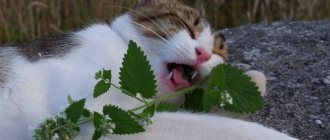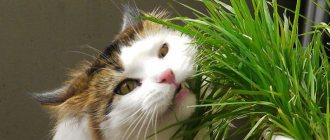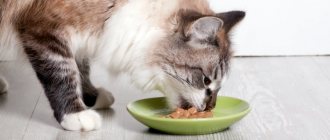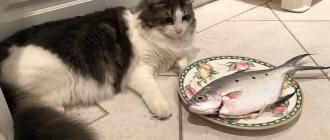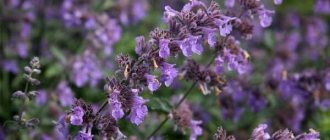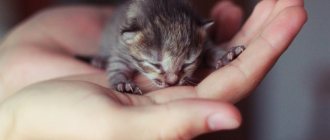Can cats have grass?
Is grass good for cats? Yes, but not all of it. There are certain plants (eg wheatgrass) that animals need. At the same time, leaves of the same type, growing close to each other, may or may not be suitable for cats. The pet will find the leaf itself by sniffing and eating the desired plant. If he doesn’t want to eat greens, it means he doesn’t need it, and there’s no need to force him. Can cats be given grass in this case? Leaves should not be forced into the throat.
Important: If your pet eats too many leaves or eats them every day, contact your veterinarian. Perhaps the animal has problems with the digestive system, vitamin deficiency.
Pharmacy for four-legged animals
Lidia Surina, candidate of biological sciences, herbal medicine consultant, answers:
– Animals not only treat us, but sometimes they themselves need our help. Herbal medicine is used in their treatment even more widely than in the treatment of humans. Official medicine, according to some experts, is 50 years behind in this regard.
Phytomins in tablets to protect the liver of dogs contain milk thistle, immortelle flowers, and corn silk. When treating allergies, animals are given sulfur, string, yarrow, plantain, burdock root, cucumber, birch leaf, dandelion root, calendula flowers. Eucalyptus leaf, oak bark, comfrey root, dandelion, violet herb, St. John's wort, wild rosemary, meadowsweet, cinquefoil, and brewer's yeast help in restoring joints.
To remove worms, a phytocomplex of centaury, fennel fruits, plantain, celandine, immortelle, yarrow, tansy, chamomile, wormwood, and meadowsweet is used.
In order to improve immunity, phytomins are used, which include the following plants: echinacea flowers, bedstraw, meadowsweet, St. John's wort, pine and birch buds, clover flowers, fireweed, rose hips, yarrow, licorice root, skimmed milk powder. These pills allow you to quickly improve your health. The blood formula is restored by “Hematodog” and “Hematoket”. The drug "Hematoket" contains flowers of echinacea, clover, fireweed, meadowsweet, yarrow, licorice roots, rose hips, St. John's wort, lactose and albumin. Antibiotics are used extremely rarely in treatment. If they do give an injection, the animal is petted beforehand and given something tasty.
There were several veterinarians in my family: my husband Viktor Vladimirovich Levitsky, aunt Gelena Ivanovna Safonova, father-in-law Vladimir Stanislavovich Levitsky. The husband headed the department of anatomy at the Omsk Veterinary Institute, and gave lecture courses on reindeer husbandry, dog breeding and animal physiology. He was a circus consultant for many years and treated all the animals there.
Veterinarians mainly use natural preparations in their practice. Therefore, botany is taught in universities for two years. Herbal medicine predominates in the treatment of animals.
If a dog or cat has hair loss, they are given phytomines from plants such as burdock root, birch leaf, nettle, plantain, chamomile flowers, succession grass, thyme, calamus root, licorice, yarrow, milk powder, calcium stearate and yeast. Density of hair in horses is achieved by adding sulfur, zinc oxide, collagen, glycerin, and castor oil to the shampoo-conditioner.
During the formation of teeth and bones, cats and dogs include phytomins in tablets in their diet, which include calamus root, burdock, horsetail, violet, meadowsweet flowers, calendula, birch leaf, sage, pine buds, mint and lactose. These tablets are given to rickety kittens and aging cats, for injuries, fractures and calcium leaching from bones. If animals have allergies or itching, use tablets that include cudweed, string, celandine, yarrow, plantain, burdock root, dandelion, calendula, lactose. Cats eat these tablets with pleasure.
To stimulate hematopoiesis, cats and dogs are given a complex of minerals: calcium, magnesium, copper, phosphorus, zinc and other drugs.
For dislocations, hematomas, sprains, neuritis, myositis, plexitis, Alezan gel is used. It contains essential oils: cedar, fir, cloves, eucalyptus, lavender, rosemary, phytoextracts of cinquefoil, juniper, fireweed, chestnut, elecampane, menthol, hot pepper oil, camphor, mumiyo, turpentine, chitosan, water with silver ions, glycerin and allantoin. This gel relieves swelling, pain, increases blood and lymph circulation in the skin and muscles, and restores the functional ability of muscles.
The undoubted advantage of these products is that they contain natural active ingredients. Such drugs are also great for humans.
Reasons why cats eat grass
Do cats need grass? Definitely yes. Cats are treated with grass. The main reason why a cat eats leaves is to try to solve problems with the digestive tract. Wide grass is believed to have a laxative effect, while narrow grass helps relieve indigestion.
The cat eats plants with hard leaves to clear the stomach of undigested food debris (feathers, bones). They can get stuck in the gastrointestinal tract and cause serious complications. The cat also eats grass to rid the digestive tract of hair that it swallowed when licking its fur. The hard leaves, which the pet swallows to cleanse the stomach, irritate the mucous membrane of the organ, stimulating regurgitation.
It should be noted that a cat does not always regurgitate fur. The hairs often pass through the digestive system and are excreted in the feces. The fiber that your pet gets from eating grass helps the intestines push stool out.
Why grass is good for cats: other reasons
There are other reasons why your pet eats grass:
- Nutrients. The greens that your cat eats contain fiber and beneficial substances. True, the body does not take nutrients from every herb. For example, wheatgrass is in transit. If the cat does not regurgitate the leaves, they will be released in the feces through the intestines.
- Folic acid. Plants that pets love contain folic acid - vitamin B9. It has a positive effect on the growth of the body and increases the level of oxygen in the blood.
- Stress. A cat can eat cat grass at home when it is nervous or irritated. Eating greens helps you calm down.
- Fighting worms. It is believed that under the influence of hard leaves, the intestines work better, which helps get rid of helminths. The theory is controversial, since most of the worms remain. However, some scientists argue that this is how wild animals in ancient times got rid of helminths.
- I like the taste. Why does a cat need grass? Some pets eat plants simply because they like it.
Beneficial properties of different types of herbs
Not all greens are created equal. It is better to plant several species at once, and then the pet will be able to make a choice.
Here is the grass that cats prefer:
- Wheat. Young sprouts have a pleasant sweetish taste. Wheat greens are rich in fiber and omega-3s. It is unpretentious, grows quickly and requires minimal care.
- Oats. Another plant rich in fiber. Green oats contain fats, amino acids and antioxidants.
- Barley. These greens stimulate metabolism. It contains beta-glucan and folic acid.
- Thyme. This herb has a calming effect.
- Wheatgrass. These greens most effectively cleanse your pet's stomach of fur.
- Licorice. It has a healing effect, accelerates the healing of the gastric mucosa, stimulates the digestion and endocrine system.
Seeds for germination can be mixed, then cats will be able to independently choose what to chew on.
What grass can you give to cats?
In addition to wheatgrass, cats also benefit from parsley, thyme, and rosemary. They can eat sprouted oats, barley, and wheat. What grass do cats need? They love catnip, which you can grow right on your windowsill.
If you find out what kind of grass cats like and grow catnip, be careful. It can be used to accustom a cat to a scratching post, attract attention to the toy, and relieve stress. Don't just give catnip. It is especially contraindicated for easily excitable and pregnant pets.
Medicinal herbs in finished animal feed
You can also find medicinal herbs in prepared diets for pets. As a rule, this inspires great confidence among many owners. After all, the use of natural ingredients involuntarily suggests that all other components of the food will be no less high-quality and healthy. Is it really?
Let's start with the fact that after undergoing heat treatment, medicinal herbs will probably lose some of their beneficial properties. Accordingly, there should not be so few of them. In addition, if the list of ingredients contains the wording “medicinal herbs” without deciphering the contents, then it is difficult to believe in the great natural healing power of such a component. One good thing is that such an ingredient will not harm your pet. It’s another matter if the food contains full information about the medicinal herbs it contains. It is ideal if the method of their use is indicated - drying or extract, as well as the quantity.
Among the ingredients, medicinal herbs may be designated by other names. For example, a herbal or plant complex, a mixture of herbs or herbs, herbs, dried herbs, etc.
What foods contain the ingredient “medicinal herbs”
| name of food | for dogs | for cats |
| Acana | fresh cranberries, fresh blueberries, chicory root, turmeric, milk thistle, burdock root, lavender flowers, marshmallow root, rose hips | fresh cranberries, fresh blueberries, chicory root, turmeric, milk thistle, burdock root, lavender, marshmallow root, rosemary |
| Orijen | cranberries, blueberries, serviceberry berries, chicory root, turmeric root, milk thistle, burdock root, lavender, marshmallow root, rose hips | whole cranberries, whole blueberries, whole serviceberry berries, chicory root, turmeric, milk thistle, burdock root, lavender flowers, marshmallow root, rose hips |
| Satisfaction | aromatic herbs (basil, rosemary, agrimony) | — |
| Brit Premium | herbs and fruits (cloves, citrus fruits, rosemary, turmeric, 120 mg/kg), dried chamomile (80 mg/kg), blueberry (50 mg/kg) | plant extract: rosemary, cloves, citrus fruits, turmeric (55 mg/kg) |
| Belcando | herbs (total 0.2%: nettle leaves, gentian root, centaury, chamomile, fennel, caraway, mistletoe, yarrow, blackberry leaves) | — |
| Profine | mixture of herbs (fennel, basil, sage 0.02%) | — |
| Carnilove | thyme (0.01%), rosemary (0.01%), oregano (0.01%), cranberry (0.0008%), blueberry (0.0008%), raspberry (0.0008%) | plantain (0.01%), thyme (0.01%), rosemary (0.01%), oregano (0.01%), cranberry (0.0008%), blueberry (0.0008%), raspberry (0.0008%) |
| Optimal | marigold (source of lutein) - 0.04%, burdock root, marshmallow root, chamomile flowers - 0.03%, nettle - 0.03%, thyme - 0.015% | 0.04%, marigold (source of lutein) 0.04%, burdock root, marshmallow root, chamomile flowers 0.03%, nettle 0.03%, thyme 0.015% |
| Pronature Holistic | — | spice mixture (0.02%, dried rosemary, dried parsley, dried mint leaves, turmeric) |
Medicinal herbs are certainly beneficial for the health of pets. However, you need to approach the use of such a delicate component wisely. Especially in cases of their independent introduction into the diet. Study literature and food in detail, consult with specialists. And, of course, with veterinarians regarding the use of herbal medicine. Let your beloved pets be healthy and full of strength for many happy years!
What plants are dangerous for cats?
If there is a cat at home, get rid of flowers that he could at least potentially eat:
- geraniums;
- lilies;
- aloe;
- amaryllis;
- Dieffenbachia;
- sago palm;
- violets;
- mint;
- lemon balm;
- calendula;
- lily of the valley;
- chrysanthemums.
The list of flowers dangerous for cats is long. Before you plant a new plant on the windowsill or in the garden, find out whether it will harm your pet. Do the same if there are already flowers on the windowsill when the kitten appears.
A cat is unlikely to eat toxic greens, but this possibility cannot be ruled out. The result can be tragic - from stomach bleeding to death.
Medicinal plants in animal diets
Among the medicinal herbs, there are those that are given to dogs and cats without a veterinarian's prescription. Basically, these are plants that have a general strengthening effect, to increase immunity and replenish the lack of vitamins.
If your pet's diet consists of high-quality ready-made food, then there is no need for such supplements. But for animals fed natural food at home, medicinal herbs rich in vitamins will be very useful.
What plants are good for pets?
Lingonberries are rich in vitamins A and C and are used not only for vitamin deficiencies, but also in cases of gastrointestinal disorders, in particular diarrhea.
Wild strawberries are an ideal remedy for vitamin deficiencies (many vitamins A, B1 and C), colds and loss of strength.
Rosehip is a source of vitamins B, C, K and E, as well as microelements. The best strengthening agent used for vitamin deficiencies and to strengthen the immune system.
Stinging nettle - the leaves of the plant contain vitamins A, B2, C and K, as well as folic and pantothenic acid. Young nettles collected in early spring are especially useful. Has anti-inflammatory and hemostatic properties. Used to prevent diseases of the gastrointestinal tract, liver, bladder and kidneys. Depending on the size of the breed, dogs are given 15-50 grams of nettle, and cats up to 10 grams. The plant, fresh or dried, is crushed and added to animal food.
Dandelion - in addition to vitamins, contains calcium, phosphorus, iron and manganese. The leaves and inflorescences of this plant are used as sedatives. It is also suitable for poor appetite and weakness, as well as for liver diseases.
How to plant grass for a cat in an apartment
To plant environmentally friendly greens that are healthy for your pet, you need to buy:
- light soil for flowers;
- container for planting, even a soup bowl will do;
- polyethylene film to create a greenhouse effect.
How to grow greens
- Wash the seeds and leave to soak for 1 hour.
- Pour soil into the container.
- Scatter the seeds evenly.
- Sprinkle the grains with soil.
- Water it.
- Stretch the film over the container to create a greenhouse effect, and the grains will germinate faster.
How to grow greens in gauze
If there is no soil, grass can be grown directly... in gauze. Do it like this:
- Rinse and leave the seeds to soak in cool water.
- Pour out the water and place gauze on the bottom of the container.
- Sprinkle the grains evenly onto the cloth.
- Cover the seeds with another piece of gauze.
- Pour water into a spray bottle and spray.
- Place film over the container.
After landing
Place the dishes in a warm place (in winter - on the radiator). When the seeds germinate (on 2-3 days), do not remove the film. The grass will be ripe for consumption in a week. Remove the oilcloth and show the cat the greens.
How much grass to give to a cat
How to feed a cat grass? Just show her a container of greens. Then the pet will figure it out on its own, including determining how much grass it needs. When your cat starts eating the leaves, he may vomit.
Don't punish your pet for burping, it's not on purpose. It’s better to buy hygiene products for cats, and place the container away from carpeting and upholstered furniture.
Rules for successfully growing weed for cats
Each growing kit comes with instructions to help you grow lush greens for your pet.
However, there are general rules that will help you avoid mistakes:
- Water the seeds daily, but the soil or substrate should not be too wet. The preferred watering option is spraying with a spray bottle.
- The best place for the container is a windowsill (in warmer months) or a table in a well-lit room. In winter, you should not send a jar of grass to the window, as the tender sprouts may freeze. If you place the tray next to the radiator, this will quickly dry out the substrate or other filler, and the grass will not sprout.
- You cannot cover the seeds with a thick layer of soil; the optimal thickness is 0.5-1 cm.
- A lack of light will cause the greenery to become stunted.
- You can speed up the growing process. To do this, the seeds are soaked in warm water for a couple of hours and then planted in the prepared substrate.
Grass from a container is an excellent replacement for outdoor greenery. It is not contaminated with parasite eggs and is not polluted by exhaust gases from cars. This grass will bring a lot of benefits to your pet, especially in winter.
Cat mint
It has long been noticed that cats are partial to a variety of mint, which was nicknamed lemon catnip (or mint). Cats really love to chew and smell this plant, because it has a strange effect on them: some pets calm down, others, on the contrary, become active.
Catnip is added to many pet toys to make them attractive to cats.
Attention! With the help of this plant you can accustom your pet to his house. All you have to do is put dried grass inside, and your cat will be happy to be there.
